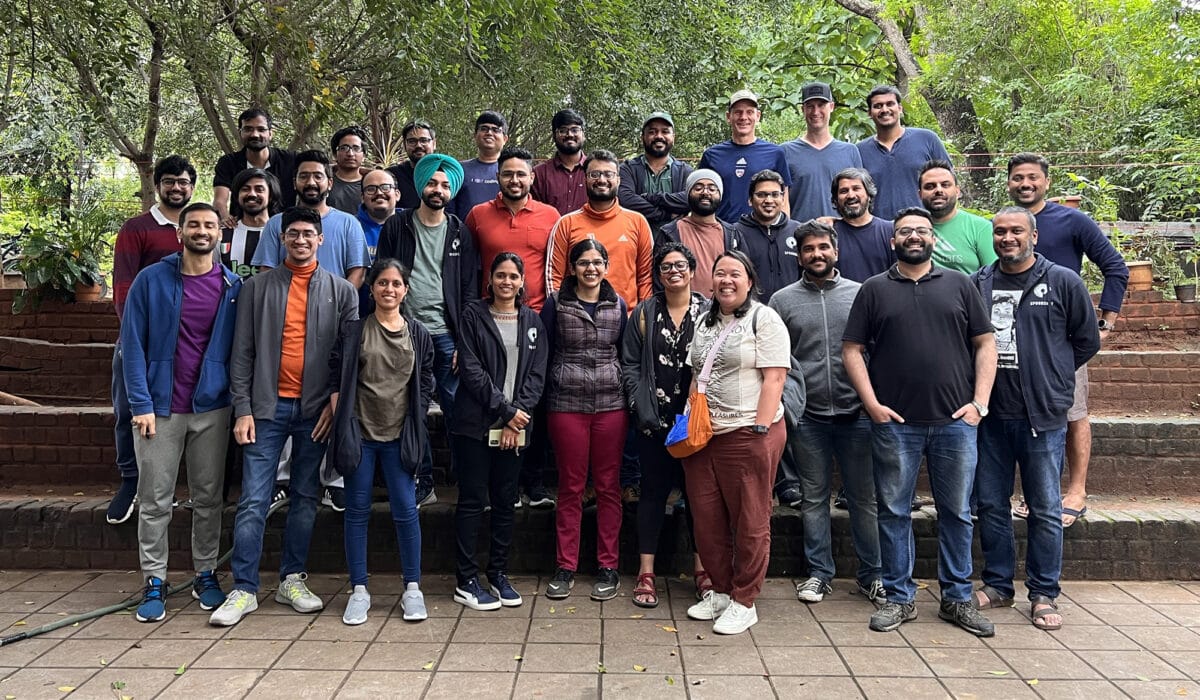Newsletter platforms that serve creators are in a race to help them grow and monetize their audiences. And the pace just kicked up a notch, with email service provider beehiiv acquiring Swapstack, a monetization platform, in September 2023.
It was a 6-figure deal for a company that raised $650,000 in funding, but one that allows the product and half of its small team to join a fast-growing and well-funded startup.
The sale closed before Swapstack’s third birthday, when it was bringing in about $300,000 annually in revenue. Yet the business had already been acquired once — before celebrating its 3-month birthday.
Jake, meet Jake: The origin of Swapstack
In September 2020, Jake Singer quit his job as a product manager at Amazon and launched a newsletter, The Flywheel, which explored business models, analyzing companies he found interesting.
Within the first two months, The Flywheel accumulated 1,000 subscribers, he shared via the newsletter.
Singer was ready to monetize.
He felt the obvious choice was to use Substack, a newsletter platform that allows writers to sell subscriptions directly to readers and was becoming popular during that time with newsletter authors.
But Singer heeded advice from newsletter writer Lenny Rachitsky. “Lenny explained that turning on the paywall effectively converts your newsletter into a job, and for me The Flywheel was much too new to make that level of commitment,” Singer recalled.
So, he turned to advertising.
But selling ads in a newsletter isn’t exactly easy. In addition to growing the audience, it requires identifying advertisers, building relationships, fielding inbound requests, managing inventory, creating ad units, writing and editing ad copy, getting brand approval, reporting performance — the to-do list goes on.
To get started, Singer applied to advertising marketplaces. He got rejected — or was ghosted — by all of them,.
“This ignited a spark of an idea for a business that would help newsletter writers like myself sell sponsorships,” Singer wrote. “Pretty soon, I met a fella in On Deck Founders who shared my name and my burgeoning interest in newsletters.”
That “fella” was Jake Schonberger, who had recently earned his master’s in design engineering at Harvard and launched The Premoney List newsletter, which helped readers find the next breakout, early-stage companies.
Schonberger, who had previously worked at Facebook, was already working on several projects when he met Singer. He called one of those projects Swapstack. He got a group of newsletter writers together to run “Swaps,” where they swapped newsletter promotions.
The two men decided they were ready to officially team up, but before diving in, they decided there was probably more of a business in the sponsorships angle than the swapping angle.
How Swapstack got acquired (the first time)
Schonberger shared that they built Swapstack in Bubble, a no-code tool used to build SaaS platforms, marketplaces and CRMs.
One of the first steps the co-founders took to grow Swapstack was to talk to newsletter writers and advertisers to understand how to best broker sponsorship deals, Singer shared on The Flywheel. With these connections, the co-founders began “matching” newsletter writers and advertisers via email introductions.
In January 2021, after six months of building, they released Swapstack Beta. Aiming to be a creator-first platform, they took a 0% cut from newsletter writers and charged a 10% invoicing fee to brands.
“Our ‘product’ now encompassed the beginning (introductions) and end (payment) of the sponsorship experience, with nothing in the middle,” Singer wrote. “And, to our amazement, people started using it.”
One party — either the newsletter creator or an advertiser — could initiate a “relationship,” where they could pitch why they’d be a good partner. If the other party agreed, Swapstack introduced the two, who then hashed out the details. From there, they would use Swapstack to request payment.
In the first month live, writers submitted 89 introduction requests with a 45% approval rate. Invoices totaled $500. In February, they saw 140 introduction requests and $3,000 in invoices.
Just two months later, in early April 2021, Swapstack was acquired — for the first time — by On Deck, a community of founders, for an undisclosed amount. The idea was that the Swapstack marketplace would become a component of On Deck as it grew its creator business.
“The prospect of selling a company that had barely just started, securing super cool jobs at a hot, rocket ship of a startup, and removing any short-term financial pressure proved too tempting to turn down, and we agreed to move forward,” Singer wrote.
But soon, the two companies began to drift apart as On Deck shifted its strategy to focus more on founders and less on creators, Singer explained, citing a tweet from the company. Mutually decided, Swapstack would once again operate independently. But, On Deck still wanted to support Swapstack — so they became the platform’s first investor.
“We were growing but not as fast as we’d have liked”
Swapstack grew into a go-to platform for both newsletter writers who wanted to monetize their content and advertisers who wanted to sponsor newsletters at scale. Some of their major growth drivers included SEO and word-of-mouth referrals, Schonberger told us.
But the biggest challenge, he shared, was the lack of consistency in performance, pricing and quality.
“Over time, we standardized much of the advertising process on both sides of the platform to reduce the impact of consistency on the business,” he said.
In June 2021, six months after the beta launch, Swapstack hit a cumulative gross merchandise value (GMV) of $100,000, Singer wrote. In September, that number had doubled. By October, they projected to hit $300,000 — and that’s when they turned to funding.
Over the lifetime of the business, Schonberger shared with us that Swapstack raised $650,000. According to The Information, funding came from friends and family and venture firms, including BBQ Capital and C Holdings.
By the time the company was sold in September 2023, they were making $25,000 in revenue a month — that works out to about $300,000 annually — with more than 2,500 newsletters on the platform, which had a collective count of 60 million readers, Schonberger told us. Over its lifetime, Swapstack helped newsletters make more than $2 million in revenue.
“We were growing but not as fast as we’d have liked,” Schonberger said. “At the same time, there was a lot of action in the newsletter market, and we knew that if we wanted to compete, we either needed to raise more money and double down, or find a strategic partnership or acquisition.”
How Swapstack got acquired, this time by beehiiv
Looking to sell, Singer and Schonberger began speaking with platforms and companies within the newsletter and influencer space. They were already familiar with beehiiv, an email service provider that was popular with creators, founded by Morning Brew alumni Tyler Denk, Benjamin Hargett and Jake Hurd.
The startup raised $12.5 million a few months before buying Swapstack, according to TechCrunch, and Swapstack was its first acquisition.
“beehiiv was the most exciting [prospect], has the most growth potential and shared our vision most directly,” Schonberger told us. “A sale to beehiiv enabled us to ensure the Swapstack vision would live on — and do so at a potentially much larger scale.”
Schonberger described the 6-figure sale as “quite difficult but exhilarating,” citing a lengthy negotiation process.
When a startup sells for around the same amount as it raised, that typically means little money in the bank for the founders. We explain more on what this scenario usually looks like in this article: What happens when a company sells for less than it raised?
Indeed, The Information reported the sale was not enough to pay back Swapstack’s investorsn.The deal… is not one the Swapstack founders had envisioned.” according to The Information. In a letter Schonberger sent to Swapstack investors, he explained the co-founders initially signed a letter of intent with beehiiv to sell for cash.
“But as the two companies got deeper into the due diligence process, beehiiv determined the original amount was ‘higher than that they felt the company was worth, and we started conversations with little negotiating leverage,’” The Information reported, citing Schonberger’s letter.
The most challenging part, Schonberger shared with us, was “personally recognizing that this was the end of the Swapstack story. It’s been a blast growing a business from the ground up, and it’s sad no matter the outcome, to say goodbye.”
Swapstack fits nicely into beehiiv’s plan to grow. The startup had recently launched an ad network, but it was short-staffed and run “very manually,” Denk shared with Axios.
“The ad network has always been our long-term goal because I’ve seen the power of that at Morning Brew, and I’ve also seen how cost intensive it is to hire a sales team and all the processes,” Denk said in that article.
Around the same time that beehiiv bought Swapstack, one of beehiiv’s competitors, ConvertKit, bought a SaaS called SparkLoop, which includes several newsletter monetization features.
Half of the four-person Swapstack team will join beehiiv, including Schonberger, he told us. Singer and another employee helped with the transition through October before moving to new opportunities, according to The Information.
“An acquisition to beehiiv enabled us to see the Swapstack vision through,” Schonberger told us, “close the Swapstack chapter in a way that we’re proud of, and go through the process of selling a company!”

